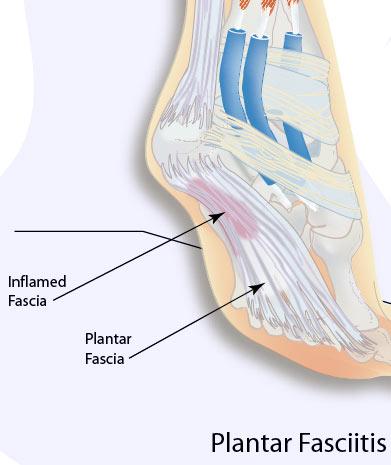Don39;t Ignore Heel Pain: Plantar Fasciitis Treatment and Prevention
Plantar Fasciitis: Symptoms, Treatment and Prevention

In this final article in both part series on Plantar Fasciitis, Brad Walker talks about the common symptoms of this painful sports accident as well as the utmost effective treatments once diagnosed. Brad also describes some very important precautionary measures that are necessary to avoid Plantar Fasciitis. A foot injury such as plantar fasciitis generally occurs in one foot. Bilateral plantar fasciitis is different and tends to be the consequence of a systemic arthritic condition that is very rare among runners. Males suffer from a somewhat increased incidence of plantar fasciitis than females, perhaps therefore of increased weight in conjunction with greater swiftness and surface impact, as well as less flexibility in the foot.Typically, the patient of plantar fasciitis encounters pain upon increasing after sleep, particularly the first rung on the ladder out of bed. Such pain is tightly localized at the bony landmark on the anterior medial tubercle of the calcaneus. In some cases, pain may prevent the sportsman from walking in a normal heel-toe gait, causing an unusual walk as means of settlement. Less common areas of pain are the forefoot, Calf msucles, or subtalar joint.After a brief period of walking with this kind of feet injury, the pain usually subsides, but returns again either with vigorous activity or prolonged standing or walking. Within the field, an changed gait or abnormal stride routine, along with pain during running or jumping activities are tell-tale symptoms of plantar fasciitis and should be given fast attention. Further signs of the harm include poor dorsiflexion (lifting the forefoot off the bottom) anticipated to a shortened gastroc complex, (muscles of the leg). Crouching in a complete squat position with the sole of the feet flat on the floor can be utilized as a test, as pain will preclude it for the athlete experiencing plantar fasciitis, triggering an elevation of the heel due to tension in the gastroc complex.TreatmentTreatment of plantar fasciitis is sometimes a drawn out and aggravating process. A program of rehabilitation should be performed with the aid of someone certified and proficient in the affliction. Typically, plantar fasciitis will require at least six weeks and up to half a year of conservative good care to be completely remedied. Should such efforts not provide pain relief to the athlete, more ambitious procedures including surgery may be considered.The original goals of physical remedy ought to be to increase the unaggressive flexion of the foot and improve overall flexibility in the foot and ankle, eventually leading to a full return to normal function. Long term inactivity in energetic sports is usually the price to be payed for thorough recovery. 1 / 2 measures can result in a chronic condition, sometimes severely limiting athletic ability.As a large amount of time is spent in bed during sleeping time, it's important to ensure that the bed linens at the foot of the foundation do not constrict the foot, leading to plantar flexion where the foot is bent straight out with the toes pointing. This constricts and in that way shortens the gastroc organic, worsening the condition. A home heating pad positioned under the muscles of the calf for a few momemts prior to increasing may help release tension, increase blood circulation in the low leg and decrease pain. Also while asleep, a nighttime splint may be used in order to hold the rearfoot in a natural position. This will likely assist in the restoration of the plantar fascia and ensure that the ft . won't become flexed during the night.Careful attention to footwear is crucial in avoiding ft . injuries. Every work should be made to wear comfortable shoes with proper arch support, fostering proper ft . posture. Should arch supports prove insufficient, an orthotic sneaker should be considered. Fortunately, most instances of plantar fasciitis reply well to non-operative treatment.Recovery times however vary enormously in one athlete to some other, depending on age group, general health and health as well as severity of injury. A wide period between 6 weeks and 6 months is usually sufficient for proper therapeutic. Additionally, the setting of treatment must be flexible depending on details of a specific athlete?s accident. Methods that establish successful in one patient, might not exactly improve the harm in another.Early on treatment of foot injuries typically includes the utilization of anti-inflammatory medication, icing, stretching activities, and heel inserts and splints. Cortisone shots may be essential to achieve satisfactory treatment and retard swelling. In later periods of the treatment process, typically after the first week, ice should be discontinued and substituted with temperature and massage.It is essential that any activity recognized to produce soreness or stress to the plantar fascia be immediately discontinued, including any activity relating repeated impact of the heel on a difficult surface, particularly, working. Should pain associated with the personal injury persist, additional diagnostic studies should be undertaken to rule out other, more exotic factors behind heel pain including stress fractures, nerve compression traumas, or collagen disorders of the skin.
Don39;t Ignore Heel Pain: Plantar Fasciitis Treatment and Prevention 's Wallpaper
Related Images with Don39;t Ignore Heel Pain: Plantar Fasciitis Treatment and Prevention
plantar fasciitis is a condition where the plantar fascia of the foot

Home / Injury Info Center / Ankle Injury Guide / Plantar Fasciitis

Nail Moreover Plantar Fasciitis Treatment Together With Home Remedies

plantar fasciitis symptoms





0 komentar: